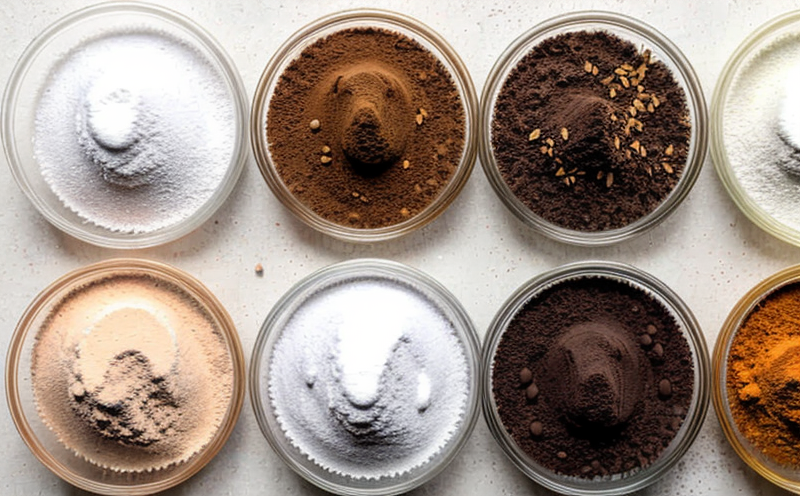ASTM D4519 Tartrazine and Sunset Yellow Detection in Foods
The detection of tartrazine (FD&C Yellow 5) and sunset yellow (E110, FD&C Yellow 6) in foods is a critical component of food safety and quality assurance. These two synthetic colorants are widely used in the food industry to enhance product appearance; however, their presence may be regulated or restricted based on health concerns, allergen labeling requirements, and other legal standards.
ASTM D4519 provides a validated method for detecting tartrazine and sunset yellow residues in foods using high-performance liquid chromatography (HPLC) with diode-array detection. This analytical technique allows for precise identification of these colorants even at trace levels, ensuring compliance with international standards such as ISO 21783:2019 and FDA regulations.
The testing process involves several key steps:
- Sample preparation
- Precipitation using zinc acetate to remove interfering components from the sample matrix
- Injection of the sample into the HPLC system for separation and quantification
- Data interpretation through comparison with standard solutions
The methodology ensures accurate detection, but it is important to note that proper sample preparation can influence results. For instance, using a homogenized sample matrix reduces variability, while ensuring the correct volume of extract is injected into the HPLC prevents overloading and potential loss of sensitivity.
Quality managers and compliance officers should be aware of the regulatory environment surrounding these colorants to ensure accurate testing and reporting. The use of validated methods like ASTM D4519 helps maintain consumer trust by ensuring food products meet safety standards.
In addition, R&D engineers benefit from this service as it allows them to monitor trends in food coloring usage or explore new formulations without compromising on regulatory compliance. Procurement teams can also leverage these tests to verify the authenticity of raw materials and finished goods against declared specifications.
Scope and Methodology
The ASTM D4519 test method focuses on determining tartrazine (E102) and sunset yellow (E110) in various food matrices. The scope includes both ready-to-eat products as well as processed foods like beverages, confectionery, sauces, and dressings.
The methodology involves several key steps:
- Sample collection: Representative samples are collected from production batches or purchased directly from retailers.
- Preparation: Samples undergo homogenization to ensure even distribution of colorants throughout the sample matrix. This step is critical for accurate quantification.
- Precipitation: A zinc acetate solution is added to the prepared sample, which precipitates proteins and other interfering substances while leaving the colorants in solution.
- Extraction: The supernatant containing tartrazine and sunset yellow is extracted using a solvent like acetonitrile.
- Injection: The extracted solution is injected into an HPLC system equipped with diode-array detection for separation, quantification, and spectral analysis.
Once the data is collected, it is compared against established standards to determine compliance. Results are reported in parts per million (ppm), which allows stakeholders to easily assess whether a product meets regulatory thresholds or internal quality targets.
The precision of ASTM D4519 lies in its ability to detect these colorants at extremely low levels, making it suitable for both routine monitoring and investigative purposes. This ensures that any deviations from expected concentrations can be identified promptly, allowing corrective actions to be taken before they affect the market.
Industry Applications
| Food Category | Examples of Products | Potential Regulatory Concerns |
|---|---|---|
| Beverages | Soda, juice drinks, alcoholic beverages | Allergen labeling, colorant content limits |
| Confectionery | Candy, lollipops, ice cream | Potential sensitivities to colorants |
| Sauces and Dressings | Ketchup, mayonnaise, salad dressings | Colorant stability in acidic environments |
| Dairy Products | Cheese, yogurt | Potential interactions with dairy components |
The results of ASTM D4519 are particularly valuable for food manufacturers who need to ensure their products meet regulatory requirements and consumer expectations. By accurately detecting tartrazine and sunset yellow, companies can maintain compliance across different markets while also addressing specific customer demands related to allergen labeling or colorant content.
Quality and Reliability Assurance
- Data Reproducibility: ASTM D4519 ensures high levels of reproducibility through standardized procedures for sample preparation, extraction, and injection. This minimizes variability between different laboratories and analysts.
- Method Validation: The test method is validated against known standards to ensure accurate detection across a wide range of food matrices. This validation process involves rigorous calibration studies and inter-laboratory comparisons.
- Sensitivity: The HPLC system used in ASTM D4519 can detect tartrazine and sunset yellow at levels as low as 0.2 ppm, which is well below the maximum allowable limits specified in many regulatory frameworks.
- Traceability: All test results are traceable to international standards such as ISO/IEC 17025:2017 for laboratory accreditation and ISO/IEC 17034:2019 for proficiency testing.
The reliability of ASTM D4519 is further enhanced by ongoing quality control measures, including regular calibration of instruments and participation in proficiency testing programs. These practices ensure that the test results are consistent, accurate, and reliable, providing stakeholders with confidence in the integrity of the data.





